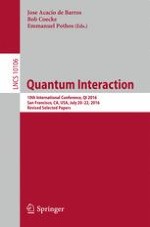2017 | Buch
Quantum Interaction
10th International Conference, QI 2016, San Francisco, CA, USA, July 20-22, 2016, Revised Selected Papers
herausgegeben von: Jose Acacio de Barros, Bob Coecke, Emmanuel Pothos
Verlag: Springer International Publishing
Buchreihe : Lecture Notes in Computer Science

